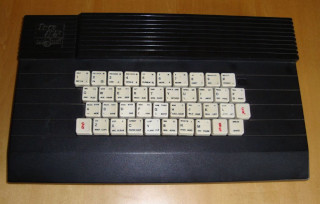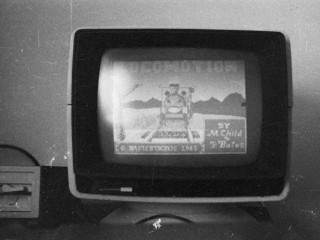best viewed with NetSurf

A selective history of computers Prologue
If you're reading this text, you almost certainly have a computer in front of you and we all know how to use one, thanks to information campaigns conducted by the computer industry
Computers are essential to our lives, because without them, we couldn't play Quake, watch movies or listen to music from the internet. Sometimes, computers are even used to make calculations. In the beginning, however, people didn't have time to play Quake, because they had to hunt animals
Agriculture was the key development in the rise of sedentary human civilization, whereby farming of domesticated species created food surpluses that enabled people to live in cities. The history of agriculture began thousands of years ago.
Because agriculture allowed people to create food surpluses, they started having time for other activities besides trying to survive, like art or weaving unnecessarily complicated textiles, using loomsA drawloom is a hand-loom for weaving figured cloth. In a drawloom, a "figure harness" is used to control each warp thread separately. A drawloom requires two operators, the weaver and an assistant called a "drawboy" to manage the figure harness. [...] The draw loom for patterned weaving was invented in ancient China during the Han Dynasty.
Drawlooms allowed complex patterns to be obtained by raising certain warp threads at a time. The drawboy was a boy whose job was to raise those threads by pulling some cords attached to them, which was a very tedious activity.The Industrial Revolution
The Industrial Revolution
The industrial revolution caused many families from the countryside to migrate to
the cities to look for work, as everything was slowly shifting from manual labor to automated machines.
[...]
During this time, as business was booming, some factories couldn’t afford to employ adult workers that
required high pay. As a result, they turned to children. Children under the age of 14 years were employed
to work at textile factories and coal mines in horrible conditions with low wages.
[...]
There were many reasons why children were employed to work in the factories. As aforementioned, one of
the main reasons was the significant difference in pay. Estimates show that children made 10-20% of what
adults made doing the same work. Thus, the owners saved money. Second, children were generally more
obedient and accepting of punishment than adults, so they were easier to control as well, whereas an
adult would retaliate.
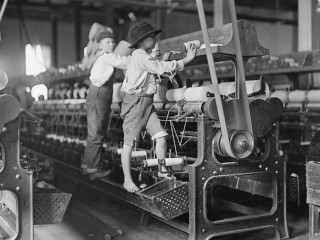
|
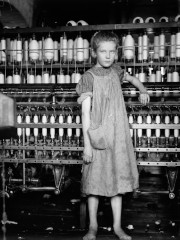
|
Sometimes, the children weren’t tall enough to operate the machines safely and had to stand on top of the machines to reach the spindles. Furthermore, the owners of the factories gave these children ill-fitting clothing which was meant for adults. This was a huge risk to the safety of the children because it was very much possible for the clothing to get stuck in the various gears of the machine. Unfortunate children have also died because of this.
Possibly with the intention of helping some of the child slavesThe Jacquard Loom is a mechanical loom that uses
pasteboard cards with punched holes,
each card corresponding to one row of the design. Multiple rows of holes are punched in the cards and
the many cards that compose the design of the textile are strung together in order. It is based on
earlier inventions by the Frenchmen
Basile Bouchon
![]() (1725), Jean-Baptiste Falcon (1728) and
Jacques Vaucanson
(1740).
(1725), Jean-Baptiste Falcon (1728) and
Jacques Vaucanson
(1740).
Boys as young as four climbed hot flues that could be as narrow as 81 square inches
(9 × 9 inches or 23 × 23 cm). Work was dangerous and they could get jammed in the flue, suffocate or burn
to death.
[...]
They were often put up hot chimneys, and sometimes up chimneys that were alight in order to extinguish the
fire. Chimneys with sharp angles posed a particular hazard. These boys were apprenticed to the sweep, and
from 1778 until 1875 a series of laws attempted to regulate their working conditions, and many firsthand
accounts were documented and published in parliamentary reports. From about 1803, there was an alternative
method of brushing chimneys, but sweeps and their clients resisted the change, preferring climbing boys to
the new humane sweeping machines.
Iqbal Masih ([...] 1983 – 16 April 1995) was a Pakistani child
labourer and activist who campaigned against abusive child labour in Pakistan.
[...]
At the age of four, he was [sold as a slave] by his family to help them pay off their debts. Iqbal's
family borrowed 600 rupees (less than
US$12.00 at the time) from
a local employer who owned a carpet weaving business. In return, Iqbal was [forced] to work as a
carpet weaver until the debt was paid off.
At the age of 10, Iqbal escaped his slavery, after learning that bonded labour had
been declared illegal by the Supreme Court of Pakistan. He escaped and attempted to report his employer
Ashad to the police, but the police brought him back to the factory seeking a finder's fee for returning
escaped bonded labourers.
[...]
Following his death, Pakistani economic elites responded to declining carpet sales by denying that they
were using bonded child labour in their factories and by employing the Federal Investigation Agency (FIA)
to brutally harass and arrest activists working for the BLLF. The Pakistani press conducted a smear campaign
against the BLLF, arguing that child labourers received high wages and favourable working conditions.
The use of replaceable punched cards to control a sequence of operations is considered an important step in the history of computing hardware
The Analytical Engine was a proposed mechanical general-purpose computer designed by English
mathematician and computer pioneer Charles Babbage. It was first described in 1837 as the successor to
Babbage's
difference engine,
which was a design for a simpler mechanical calculator.
The Analytical Engine incorporated an arithmetic logic unit, control flow in the form of conditional branching
and loops, and integrated memory, making it the first design for a general-purpose computer that could be
described in modern terms as
Turing-complete
![]() .
In other words, the structure of the Analytical Engine was
essentially the same as that which has dominated computer design in the electronic era. The Analytical Engine
is one of the most successful achievements of Charles Babbage.
.
In other words, the structure of the Analytical Engine was
essentially the same as that which has dominated computer design in the electronic era. The Analytical Engine
is one of the most successful achievements of Charles Babbage.
In 1950, Shannon calculated, based on a game tree complexity of 10120 [, that] a computer [...] [which] could evaluate a terminal node in 1 microsecond would take 1090 years to make its first move.
I wrote a program that can solve the game of chess and it's possible that (on a modern computer) it could accomplish the task even a little faster, though it would still take significantly longer than the estimated age of the universe, which is less than 1011 years.Unlike in the case of Jacquard's loom, which was not programmable because the punched cards encoded only the patterns to be woven, the cards used by the Analytical Engine would encode instructions (programs) as well as data. Babbage was not able to complete any of his machines. In 1941, Konrad Zuse, a civil engineer, completed the first working programmable, fully automatic digital computer, Z3
The first Turing-complete computer was ENIAC (Electronic Numerical Integrator and Computer)
Although ENIAC was designed and primarily used to calculate artillery firing tables for the United States Army's Ballistic Research Laboratory (which later became a part of the Army Research Laboratory), its first program was a study of the feasibility of the thermonuclear weapon.
Home computersVacuum tubes used in the first electronic computers were eventually replaced by transistors and integrated circuits, leading to increased speed, efficiency and reliability. Various types of computers were developed, called mainframe computers, minicomputers, Lisp machines
Home computers were a class of microcomputers that entered the market in 1977 and became
common during the 1980s. They were marketed to consumers as affordable and accessible computers that, for the
first time, were intended for the use of a single nontechnical user.
[...]
Their most common uses were playing video games, but they were also regularly used for word processing and
programming.
The video above shows some very advanced technology which could have been available to us thanks to some well-intentioned extraterrestrials and the visionary behind the Apple company, Steve Wozniak
The Apple II division - other than Wozniak - was not invited to the Macintosh introduction event, and Wozniak was seen kicking the dirt in the parking lot. Although Apple II products provided about 85% of Apple's sales in early 1985, the company's January 1985 annual meeting did not mention the Apple II division or its employees, a typical situation that frustrated Wozniak.
Therefore, thanks to the second Steve, we no longer have access to a technology which would have solved all our problems related to energy, transportation, global heating, resource exhaustion, pollution and persistent environmental toxins.
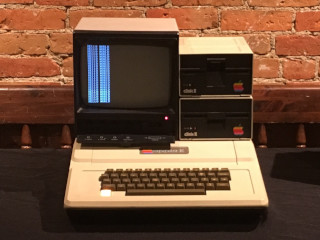 Original Apple II
Original Apple II
|
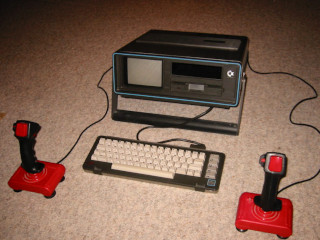 Commodore SX-64, the first commercial full-color portable computer
Commodore SX-64, the first commercial full-color portable computer
|
Some time after their introduction, home computers gradually started being referred to as personal computers, or PCs. Two types of PCs, made in 1995 and 1999, are shown below.
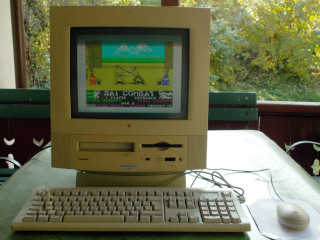 Macintosh Performa 5200 (1995) running
a ZX Spectrum game
Macintosh Performa 5200 (1995) running
a ZX Spectrum game
|
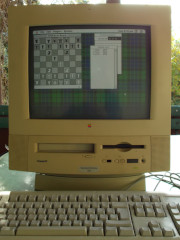 Macintosh Performa 5200 running GNU Chess
Macintosh Performa 5200 running GNU Chess
|
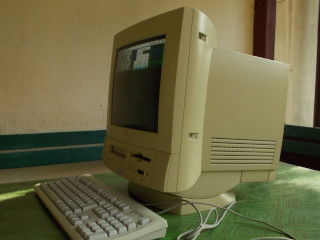 Macintosh Performa 5200
Macintosh Performa 5200
|
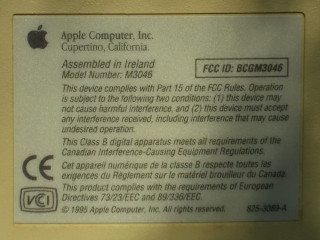 Macintosh Performa 5200
Macintosh Performa 5200
|
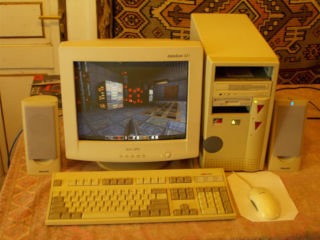 PC with
Intel CPU at 400 MHz (1999), running Quake (with
tyrquake-0.61)
PC with
Intel CPU at 400 MHz (1999), running Quake (with
tyrquake-0.61)
|
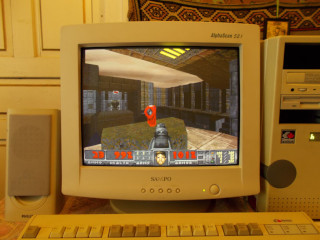 PC running
Freedoom
(with PrBoom+)
PC running
Freedoom
(with PrBoom+)
|
A few programs running on the Macintosh PC from the pictures above are shown in the following video: a program for making calculations, GNU Chess, some ZX Spectrum games running in an emulator and some educational software
Current situation
We are living in times of rapid scientific and technological progress, which constantly makes our lives better and easier. A few (translated) quotes from a Romanian almanac published in 1968, called Science and Technology, are below.
Page 8: According to Jean Fourastié's assumptions, the man from the year 2000 will work only 30 hours a week, 40 weeks a year, 35 years in his lifetime and about 42000 hours in his entire existence. An existence estimated on average, for the same year 2000, at 80 years and 700000 hours of life respectively.
Page 10: Every day brings us more and more news about the use of robots in all areas of life, which causes, we could say, "miraculous" changes in technology, in industry, transport, agriculture etc. Essential in all of this is the fact that the physical effort exerted by people in productive activities decreases and the productivity of labour increases rapidly.
As the almanac from 1968 shows, computers and automation greatly reduce the effort exerted by people in productive activities
The Foxconn suicides were a spate of suicides linked to low pay and brutal working
conditions at the Foxconn City industrial park in Shenzhen, China,
[...]
The 2010 suicides prompted 20 Chinese universities to compile an 83-page report on Foxconn, which they described
as a "labor camp". Interviews of 1,800 Foxconn workers at 12 factories found evidence of illegal overtime and
failure to report accidents. The report also criticized Foxconn's management style, which it called inhumane and
abusive.
Car Design Was Better Before Computers
[...]
corruption in the car industry goes way beyond manufacturers' faked emission-tests, their
mass-participation in war crimes, and the children they force to work in the cobalt, mica, and lithium mines.
In fact, the corruption in Car Land begins the moment you switch on a computer and load your
CAD software.
[...]
Almost every modern computer is manufactured in a Communist dictatorship, often by children. This is, after
all, the reason companies manufacture in these regions: It is cheap to manufacture in the 'Slave Zones'
because there are few human rights, and children are often used as labor.
[...]
The solution here is obvious: [GNU/]Linux.
Furthermore, the video shows how technology has helped the progress of agriculture, so that sufficient food can be available to everyone:
Dorsen hasn't eaten for 2 days now.
